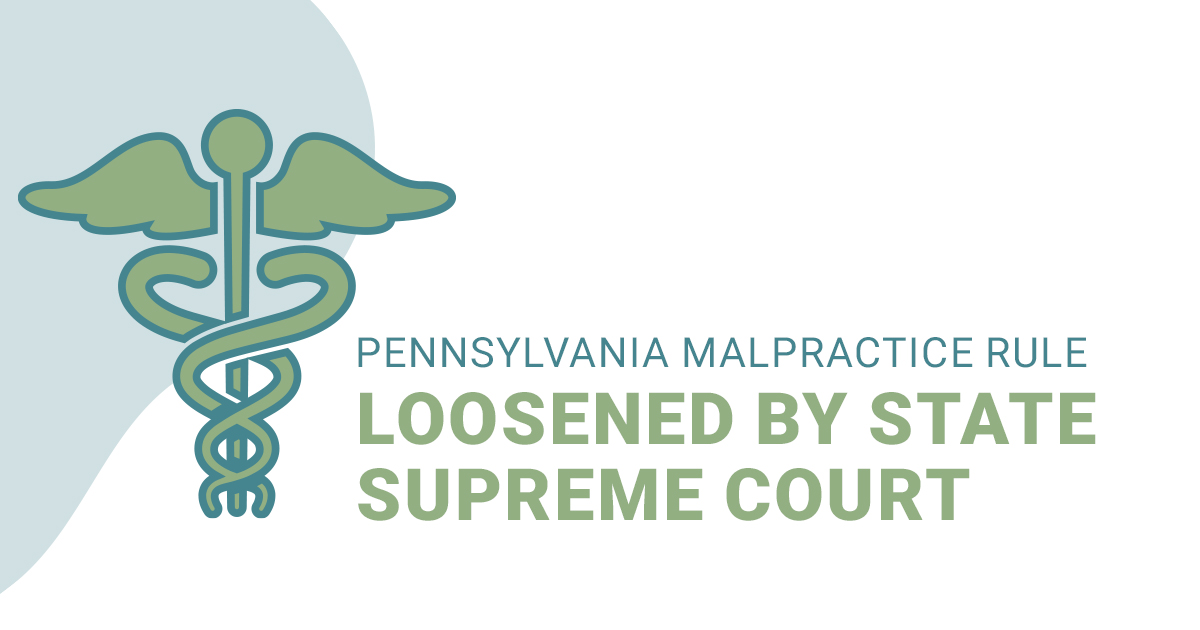Pennsylvania Malpractice Rule Loosened by State Supreme Court

Pennsylvania courts and health care providers are clashing over two fundamental principles: The right to pursue equitable justice and the ability to access quality health care.
At issue: Where do patients pursuing malpractice claims file their cases?
Until recently, they were limited to the counties where the harm allegedly occurred. Health care providers – and every other nongovernmental entity – followed the looser, standard rules of civil procedure. They could file a case in any county within the Commonwealth. A committee set up by the state Supreme Court decided that was unjust and recommended a change.
Here are the top five takeaways from the change.
The committee saw the same as a matter of justice.
While agreeing that there may have been good reasons to limit where the suits could be filed at one point, the Civil Procedural Rules Committee decided they no longer held water. What’s more, they located a fundamental injustice in the arguments of health care providers.
“There appears to be a misconception that patients harmed by the negligent actions of healthcare providers somehow enjoy a windfall verdict in more populous counties,” the committee wrote in its majority report. “Many of these patients have endured substantial injuries seriously lessening their quality of life in perpetuity, requiring permanent medical care and assistance in activities of daily living.”
In other words, while providers may have to grapple with higher malpractice insurance costs or providers leaving, those harmed by medical malpractice bear great burdens of their own.
The committee looked at three pieces of hard evidence.
Jeffrey A. Krawitz at the National Law Review highlighted three factors noted by the committee. Taken as a group, members said, they showed that the time had come for a change in how venues were selected.
- “The court’s own data showed that medical malpractice filings had significantly decreased in the past 15 years.
- “Not only was there a significant decrease in the number of cases filed, but also in the number of claim payments—resulting in less compensation for victims of medical malpractice.
- “The current venue rule provides special treatment for a particular class of defendants, with the soon-to-be-implemented changes providing fairness of process.”
Pennsylvania hospitals aren’t happy about the change.
Andy Carter is the president and CEO of the Hospital and Healthsystem Association of Pennsylvania. He told Ron Southwick of Chief Healthcare Executive that he worried about the malpractice as mentioned above costs, as well as doctors choosing not to work there. That could all ultimately lead to hospitals offering fewer services to fewer people.
“We’re going to continue the conversation pointing to the risk that this rule change puts Pennsylvania in, in terms of access to the healthcare they have now, especially in the climate we now face,” Carter said. “This is as much about the fragility of the healthcare delivery system as whatever a jury award might be. There’s a great deal at stake here for all Pennsylvanians.”
Trial lawyers see it as a long-overdue triumph of fairness.
As you might expect, they see the change as a triumph for the little guy (and gal).
“Plaintiffs in medical malpractice cases shouldn’t be limited by venue rules while the defendant enjoys a home-field advantage,” said Kila Baldwin, the president of the Pennsylvania Association for Justice, according to Angela Couloumbis and Stephen Caruso of Spotlight PA. The association represents trial lawyers in the Commonwealth.
“The new rule levels the playing field and will improve access to justice for all Pennsylvanians,” Baldwin added.
Keep your eye on city centers to figure out what happens next.
So what does this all add up to for Pennsylvanians? The Associated Press suggests that potential litigants will hightail it to major population centers.
“The decision by the state Supreme Court is likely to mean the number of such lawsuits will increase in Philadelphia and Pittsburgh, where jurors are considered to be more sympathetic to patients and more likely to produce larger verdicts,” Mark Scolforo wrote for the news service in August.
Whether that exodus occurs or not, it’s clear that Pennsylvania’s highest judges have decided that the time has come for a profound change in the state’s malpractice litigation landscape. It will be up to health care providers, their lawyers, litigants, and their attorneys to figure out what that means in practice.